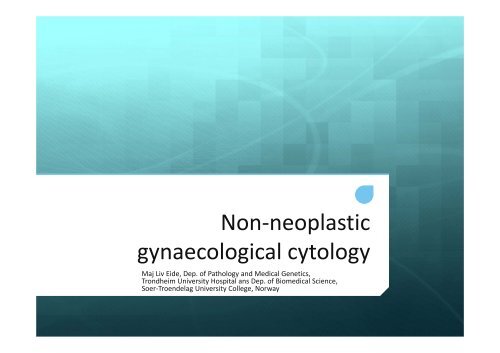Maj Liv Eide Non-neoplastic gynaecological cytology
Maj Liv Eide Non-neoplastic gynaecological cytology
Maj Liv Eide Non-neoplastic gynaecological cytology
You also want an ePaper? Increase the reach of your titles
YUMPU automatically turns print PDFs into web optimized ePapers that Google loves.
<strong>Non</strong>‐<strong>neoplastic</strong><br />
<strong>gynaecological</strong> <strong>cytology</strong><br />
<strong>Maj</strong> <strong>Liv</strong> <strong>Eide</strong>, Dep. of Pathology and Medical Genetics,<br />
Trondheim University Hospital ans Dep. of Biomedical Science,<br />
Soer‐Troendelag University College, Norway
Agenda<br />
Satisfactory smear<br />
Normal cells in cervical specimens<br />
Inflammatory conditions in general<br />
Persistent irritation<br />
o Metaplasia, tissue repair, tubal metaplasia, parakeratosis,<br />
radiation therapy, IUD changes, reactive endocervical cells<br />
and chronic inflammation<br />
Specific infections<br />
o Bacterial vaginosis, Candida albicans, Actinomyces Israeli,<br />
Trichomonas vaginalis and Herpes simplex virus
Satisfactory smear<br />
Conventional <strong>cytology</strong><br />
Conventional smear should<br />
have a minimum of approx.<br />
8000 – 12000 well‐preserved<br />
and well‐visualized squamous<br />
cells.<br />
The number shall be<br />
estimated, not counted<br />
Liquid based <strong>cytology</strong><br />
Liquid based preparations<br />
should have at least 5000<br />
well‐visualized and well‐<br />
preserved squamous cells.<br />
A minimum of 10 fields<br />
should be counted along a<br />
diameter of the circle<br />
including the centre
Minimum squamous cellularity in LBC<br />
Counting 10 fields: The average cell number per microscopic field to achieve 5000 cells<br />
is shown in the following table<br />
FN 20 ocular/<br />
10X objective<br />
FN 20 ocular/<br />
40X objective<br />
FN 22 ocular/<br />
10X objective<br />
FN 22 ocular/<br />
40 X objective<br />
Preparation<br />
diameter (mm)<br />
cells/fields cells/fields cells/fields cells/fields<br />
13 mm (SurePath) 118,3 7,4 143,2 9,0<br />
20 mm (ThinPrep) 50 3,1 60,5 3,8<br />
This method of strict criteria must not be applied to cell clustering, atrophy and cytolysis
Cervix: Normal <strong>cytology</strong> and hormones<br />
• Papanicolaous staining method<br />
• Estrogen and progesterone
Superficial squamous cells<br />
Polygonal cells with pink,<br />
transparent cytoplasm and<br />
centrally placed small, dark<br />
(pycnotic) nuclei<br />
N/C ratio approx 1:30<br />
Influenced by estrogen<br />
Ovulation
Intermediate squamous cells<br />
Polygonal cells with light<br />
blue/turqoise cytoplasm and a<br />
centrally placed, vesicular nuclei<br />
Nuclear size equals polymorphs<br />
Glycogen<br />
N/C ratio approx 1 : 20<br />
Influenced by progesteron<br />
2.half of menstrual cycle<br />
Pregnancy
Lactobacillus and cytolysis<br />
• Lactobacillus –rod shaped<br />
bacteria<br />
• Able to lyse glycogen‐ rich<br />
intemediate cells<br />
• Converts glycogen to lactic<br />
acid<br />
• Second half of menstrual<br />
cycle and pregnancy
Parabasal squamous epithelial cells<br />
Round cells with bluegreen<br />
cytoplasm and rund to oval nuclei<br />
N/C ratio: 1 : 5<br />
Atrophy<br />
Postmenopause<br />
Postpartum, when breast feeding<br />
(some parabasal cells with<br />
glycogen)<br />
Oral contraceptive pills<br />
(progesteron)
Endocervical columnar cells<br />
Columnar shaped cells when<br />
viewed from the side<br />
Either secretory or ciliated cells<br />
Secretory cells with mucin vacuoles<br />
(one single or many)<br />
Ciliated cells have denser<br />
cytoplasm (bluegreen)<br />
N/C ratio: approx. 1 : 3<br />
Single, strips or in sheets<br />
(honeycomb pattern)
Endometrial cells<br />
•Epithelial and stromal cells<br />
•The nuclei of epithelial cells are the size of<br />
intermediate squmaous cells with<br />
coarse chromatin due to degeneration<br />
•Scant cytoplasm, often finely vacuolated<br />
•Spontanously shedded endometrial cells: A<br />
double contour cell ball with centrally placed<br />
stroma surrounded by epithelium<br />
•Endometrial cells shed after day 10‐14 or in<br />
the menopause is considered abnormal
Metaplasia – normal physiologic process<br />
Squamoucolumnar<br />
junction<br />
Transformation zone<br />
‐ histology<br />
Metaplastic cells ‐<br />
<strong>cytology</strong><br />
Metaplastic process: Reserve cell hyperplasia, immature squamous metaplasia and<br />
mature squamous metaplasia. Replaces damaged endocervical, columnar cells.
Squamous metaplastic cells<br />
Immature<br />
Parbasal‐like cells<br />
Cobblestone pattern or single<br />
Thick, dense blue‐green<br />
cytoplasm with thicker<br />
ectoplasm<br />
”Spider cells” due to forcibly<br />
scarped cells<br />
LBC: Can look like endocervical<br />
cells or HSIL<br />
Mature<br />
Intermediate squamous‐like<br />
cells<br />
Rounded cell outlines<br />
Slightly, dense cytoplasm<br />
Remnants of cobblestone
Squamous metaplasia<br />
Conventional LBC
Euplasia –normal activity<br />
Round to oval nuclei<br />
Finely granulated chromatin<br />
Evenly distributed and thin and even<br />
chromatinic rim<br />
Uniform nuclei
Fra Compendium in Clinical Cytology, R.Mecsei
Cell damage<br />
Inflammatory reaction with<br />
degenerative changes,<br />
thereafter<br />
regenerative/reactive changes<br />
or cell death
Retroplasia<br />
• Variation in nuclear size<br />
• Loss of water control<br />
• Swelling of nuclei due to increased water intake<br />
• Wrinkled nuclear membrane due to loss of water<br />
• Blurred or clumped chromatin<br />
• Eosinophilia<br />
• Amphophilia<br />
• Vacuolisation<br />
• Halo
Infection > decreased activity<br />
Degenerative changes:<br />
Blurred or clumped chromatin<br />
Halo<br />
Amphophilia<br />
False eosinophilia<br />
Vacuolisation
Necrosis<br />
Irreversibel exogene cell damage > death<br />
Karyopycnosis Karyorrhexis Karyolysis<br />
The cells burst in the end and the cell content leaks into<br />
the tissue, creating an inflammatory response unlike<br />
apoptosis.
Tissue repair<br />
Repair is visualised as regenerative cells<br />
Often seen in patients with recurrent<br />
cervicitis or after biopsies and laser therapy<br />
Nuclear variation in size, shape and<br />
enlargement<br />
Prominent nucleoli and finely granulated,<br />
evenly distributed chromatin, but not<br />
hyperchromatic<br />
Abundant cytoplasm and cohesive cells in<br />
sheet‐like arrangements<br />
Leukocyte infiltration in groups
Tubal metaplasia (TM)<br />
Benign, non<strong>neoplastic</strong> replacement of columnar cells<br />
(endocervical or endometrial)<br />
Cells characteristic of the fallobian tube<br />
Usually occurs high up in the endocervical canal and<br />
common finding due to use of endocervical brush<br />
Hyperchromatic crowded groups and stratified strips<br />
with high N/C ratio and dark, but finely granular, even<br />
chromatin<br />
The finding of terminal bars and cilia is most helpful<br />
in recognising tubal metaplasia
Radiation damage<br />
http://nih.techriver.net/atlas.php<br />
The cytological changes due to<br />
radiation can be transitory, last<br />
for 1‐2 years or persist.<br />
Both tumour cells and normal<br />
cells are affected but tumour cells usually<br />
clear rapidly (6‐8 weeks)<br />
>Cytological criteria<br />
Enlarged nuclei often multiple, pale or<br />
dark with N/C ratio relatively unchanged.<br />
Cytoplasm with amphophilia<br />
Vacuolated cytoplasm (acute radiation<br />
change)<br />
Repair/regeneration is common
IUD changes<br />
The Pap Test by RM DeMay, ASCP Press 2005<br />
Chronic irritation due to IUD tail and body<br />
affecting the tissue<br />
> Cytological criteria<br />
Reactive glandular (endocervical or<br />
endometrial cells) or metaplastic cells with<br />
prominent nucleoli and hypervacuolisation<br />
(“bubble‐gum cells”).<br />
Hyperplastic endocervical, columnar cells may<br />
form papillary tissue fragments.<br />
A few, atypical appearing, single endometrial<br />
cells (IUD cells) or shed in clusters.<br />
Clean background
Parakeratosis<br />
The Pap Test by RM DeMay, ASCP Press 2005<br />
Benign keratotic reaction, but<br />
may conceal underlying<br />
lesion, most often associated<br />
with condyloma or SIL.<br />
> Cytological criteria<br />
Single, flat cells, layered strips<br />
of cells or concentrically<br />
arranged “pearls”. Usually<br />
orange stained cytoplasm<br />
and centrally, pycnotic and<br />
hyperchromatic nuclei.
Reactive endocervical cells<br />
The Pap Test by RM DeMay, ASCP Press 2005<br />
Reactive endocervical cells are<br />
common (hyperplasia, polyps,<br />
cervicitis)<br />
>Cytological criteria<br />
•Cells ”lay flat” with enlarged,<br />
round to oval nuclei up to 4‐5<br />
times the normal area<br />
•Fine chromatin<br />
•Bi‐ and multinucleation<br />
•Prominent nucleoli<br />
•Maintained N/C ratio<br />
•Well defined cell borders
Chronic (follicular) cervicitis<br />
Follicular cervicitis, synonymous with lymphoid cervicitis is an<br />
inflammatory condition involving lymphoid follicles in<br />
subepithelial areas.<br />
Associated with Chlamydia infection<br />
> Cytological criteria:<br />
Mature and immature lymphoid cells along with tingible body<br />
macrophages, which must be identified. Follicular cervicitis is easier<br />
to interpret in conventional smears than LBC due to lymhocytic<br />
dispersion in the latter.<br />
DD: Lymphoma, endometrial cells, histiocytes, metastatic tumor<br />
cells.
Chronic (follicular) cervicitis<br />
Conventional LBC
Bacterial vaginosis<br />
• Thin, homogenous discharge<br />
• Vaginal ph > 4,5 due to lack of<br />
lactobacilli<br />
• Gardnerella vaginalis, one of the<br />
major species assosiated with<br />
bacterial vaginosis<br />
> Cytological criteria<br />
1. Clue cells: Coccobacillus sticked to<br />
squamous cells<br />
2. Lack of inflammatory cells and<br />
lactobacilli
Fungal infection > due to Candida<br />
Conventional LBC<br />
Pseudohyphae (sticks) and yeast (stones), which may look like “balloon dogs”.<br />
Budding may be seen. The pseudohyphae usually stain pale pink or blue and are<br />
surrounded by a small, clear halo.<br />
> Cytological criteria: Mildly enlarged nuclei, with slight hyperchromasia and<br />
hyperkeratosis: Lysed neutrophils are common. DD: ASC‐US
Actinomyces israeli<br />
Conventional LBC<br />
Actinomyces is associated with IUD usage<br />
Actinomyces are branching, filamentous bacteria and in Pap test the<br />
bacteria live symbiotically with colonies of bacteria forming dark‐blue<br />
masses with spidery legs (actinomyces)
Trichomonasinfection<br />
Conventional LBC<br />
Trichomonas vaginalis is an oval or pear‐shaped protozoan. The nucleus of the<br />
trichomonas is thin, pale and eccentrically located and must be seen to identify<br />
this organism. Flagella may be seen in LBC.<br />
Cytological changes: Pseudokeratinization, amphophilia and false eosinophilia.<br />
Slight nuclear enlargement, hyperchromasia and perinuclear halos are common.
Herpes simplex virus infection<br />
Conventional LBC<br />
http://nih.techriver.net/atlas.php<br />
Multinucleated cells with enlarged nuclei and molding. The chromatin marginates<br />
due to viral particles filling the nuclei, resulting in ground glass appearance. The<br />
nuclear membrane appears thickened due to condensed chromatin. Intranuclear<br />
inclusions are highly characteristic when present, but is found only in half of the<br />
cases.
Workshop<br />
Cases with both Conventionals and LBC (ThinPrep)and a<br />
number of cases with LBC Surepath only and ThinPrep<br />
only<br />
NILM –negative for intraepithelial lesion or malignancy<br />
Please follow the arrows when passing the slides around





